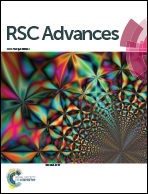Enhanced red emission in Ca0.5La(MoO4)2:Eu3+ phosphors for UV LEDs
Abstract
La3+ was introduced into CaMoO4 to form a novel compound with the chemical formula Ca0.5La(MoO4)2 and Eu3+ activated the new compound was synthesized by a solid-state reaction method. An enhanced red emission at 615 nm originating from the 5D0–7F2 transition of Eu3+ was reported in the Ca0.5La(MoO4)2:Eu3+ phosphor. XRD patterns indicate a structural similarity to CaMoO4. The red emission intensity of the Ca0.5La(MoO4)2:Eu3+ phosphor is 5.92 times higher than that of CaMoO4:Eu3+. Photoluminescent spectra, diffuse reflection spectra and lifetime measurements indicate that the red emission enhancement is due to the increase of the 7F0–5L6 absorption intensity of Eu3+ in the distorted crystal field of the Ca0.5La(MoO4)2:Eu3+ phosphor. Enhanced red emission, stronger 7F0–5L6 absorption intensity, and high color purity indicate that the Ca0.5La(MoO4)2:Eu3+ phosphor is a promising red phosphor for UV LEDs. The luminescence properties of the Bi3+ co-doped Ca0.5La(MoO4)2:Eu3+ phosphor was also investigated. Although Bi3+ co-doped into the Ca0.5La(MoO4)2:Eu3+ phosphor broadens PLE spectra in the UV range and makes it more suitable for UV pumped LEDs, it decreases the distortion and induces a new quenching path, and thus makes the emission intensity decrease.


 Please wait while we load your content...
Please wait while we load your content...